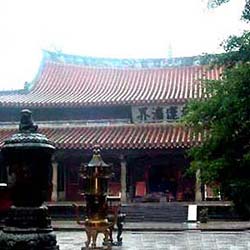
One of the most interesting sites of this ancient port, the temple, first constructed in 686, was originally named the Lotus Flower Temple. The temple was later renamed several times until finally in 738, the Tang Emperor Xuan Zong, a devout Buddhist, ordered every large town in China to name one of its temples "Kaiyuan," the title of his reign. The temple has since been known as Kaiyuan Temple.
The temple is one of the outstanding examples of Chinese architecture and art. Flying musicians are carved on pillars that support the roof of the Hall of One Hundred Pillars. The two pagodas that stand opposite each other in front of the main hall in the temple, Purple Cloud Hall, are octagonal five-tier stone buildings with exquisite carvings. Two images of Buddha are carved on each of the eight sides. Forty ancient Buddhist tales are inscribed on the walls of one of the pagodas.
There are numerous other stone carvings in the temple -- figures resembling the Sphinx, animal heads and birds, dragons and tigers. Interestingly there are columns here in ancient Greek style. Many of these rare art works were once religious decorations on other buildings in Quanzhou, later moved to Kaiyuan Temple.
Add: No. 176, West Street, Quanzhou City, Fujian Province;
Entry ticket: 10 yuan;
Opening hours: 7:30 - 17:30;
Traffic: Bus No.2 or Tourist Bus No. 601;
Tel: 0595-2383285 or 0595-22383036.
(China.org.cn April 7, 2006)
|

